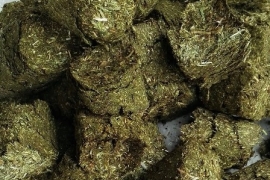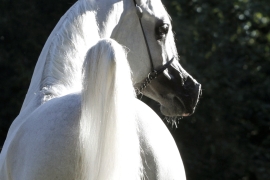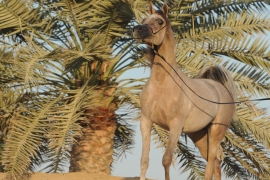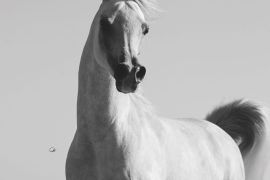A sketch study of the the Arabian Face: the Ears
The ears are such a prominent trait of the Arabian horse breed that they too, (as the eyes discussed in my previous post) strongly contribute to the overall beauty of the face. Their small, tipped ears, flicking back and forth, show intelligence, alertness and intensity. They are one of the best ways to read a horse’s mood so it only makes sense that they are an important feature!
When I create any art, I consider the ears a central part of constructing the mood of the painting. Are they forward and intense, creating a sense of excitement or urgency? One side tilted outward in apprehension? Flattened against the neck in anger? They’re crucial to the emotion of the artwork.
The behavioral use of the ears is such a fascinating topic but today we will study their conformation.

The close-set, curved shape of the ears is a defining characteristic of the breed.
It is stipulated that the ears on the Arabian horse must be thin and well-shaped, with the tips curving inwards, but not touching. They sit closely together and should have full 180 degree range of motion: with the ears pointing all the way forward when alert and all the way back when expressing aggression. It is typical for the stallion to have smaller ears than the mare and is something I am careful to watch for when I paint or draw, so that the portrayal is accurate.

It is desirable for the stallion to have slightly smaller ears than the mare. Can you tell which is which?
Horses have better hearing than humans and can detect slightly higher and lower frequencies than we can. But what makes their hearing so much more effective than ours, is their ability to pinpoint and focus towards a particular sound with the use of ten muscles in their ear; seven more than we humans have. The outer portion of the ears that uses these extra muscles to swing back and forth, listening and communicating, is built mainly out of cartilage and is called the pinna. Its cup shape captures sound and funnels it downward to the eardrum. Since the pinnae can move independent of each other, the horse is able to target specific sounds from different (even opposite) directions at the same time.

The ears should have complete range of motion, with the muscle control to point them all the way forward and all the way back on the head.
PLACEMENT
The placement of the ear is straighforward, each one is set on either side of the poll (top of the head) with its base aligned with the cheekbone. When facing forward, the inside edge of the ear should line up with the inside corner of the eye, no more than one ‘ear’s width’ apart.

Ideally, the ears should be very close-set when facing forward and alert.
SHAPE
The shape of the ear should appear very delicately constructed, regardless of whether the hair coat is clipped or left natural. The skin is very fine here and the veins are close to the surface. They are generally narrow from base to tip, but not too long, and the tips should cut a sharp, dramatic line in towards the center.

Good examples of how I like to draw my Arabian’s ears: slender and fine with prominently curved tips.
FAULTS
Since they are such a key feature of the Arabian horse, any shape, size, placement or set which goes against the breed standard is highly undesirable. Even if all you see of the horse are its ears, you should be able to tell without a doubt, whether or not they belong to an Arabian!
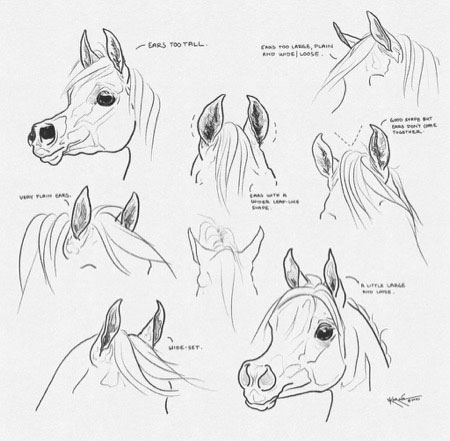
Some examples of faults in the conformation of the ears.
Loose/Lazy Ears - These are caused by a lack of control over the ear muscles. The horse is unable to bring the ears fully forward, resulting in a V shape when viewed from the front. This fault makes the horse look somewhat lazy and sleepy.
Airplane Ears - Horses with loose or lazy ears often hold them relaxed out to either side of the face creating the appearance of airplane wings.
Tall Ears - Sometimes used to describe ears that are too large, narrow and elongated from the base to the tip.
Wide-set Ears - Ears set too far apart. They aren’t always lazy (with that V shape) but ears that are wide-set have too great a distance between each other, on the poll.
Plain Ears - These are shapeless and lack the distinctive, curved tips and definition Arabian horse ears are famous for.
With art, because it is just depicting a single frame in time, it is difficult to judge many of these faults. Have a look at the sketch above that shows the range of motion of the ears... many of those could appear to be faults or they could simply be a frame of time showing the horse at rest (with its ears hanging loosly to each side) or depicting other behavioral actions that, unless you see the horse in motion or have an idea of what the rest of the body is doing, are impossible to mark down as faults.
I’ve found the only way to combat this when drawing is to make sure the rest of the horse’s body language matches the placement and direction of its ears.
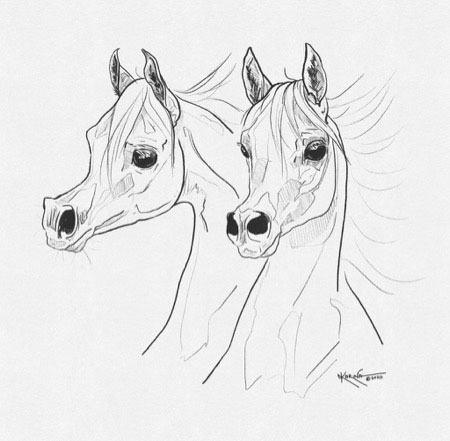
Watch your horse next time he is out in the paddock, or doing anything at all really. The ears are almost never still. They aren’t just listening, they’re speaking with them. They flick and swivel around to catch every sound or communicate the slightest emotion. Because they are so important, when I sketch, the ears are usually the first thing I start with. The Arabian just wouldn’t be the same without those elegant, expressive ears!




